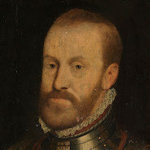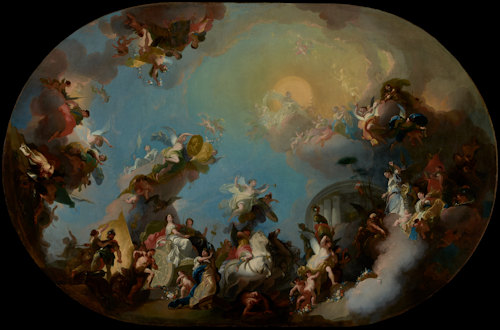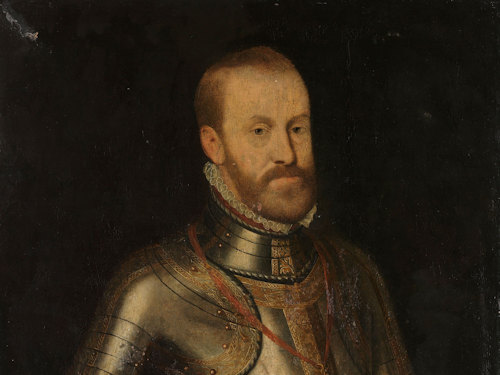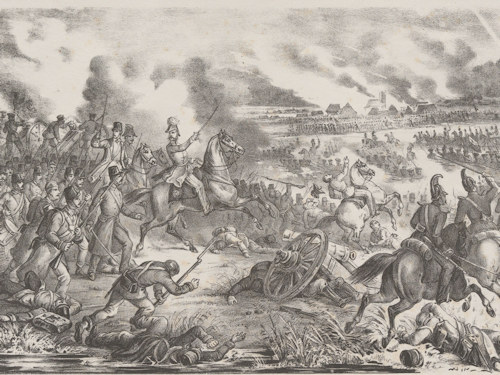
So having explained most of the official terms used to describe the Habsburg empire, what about some of the other words and concepts you come across in museums and palaces in Vienna?
- Habsburg family line also ruled in Spain
- Austrian line technically became the Habsburg-Lorraine dynasty
- You might discover alternate spellings for the family name
- Book a tour* of the Habsburg capital
- See also:
- Previous: What is Austria?
- Next: Empresses and archdukes?
Spaniards, Germans & more
So, who were the Hapsburgs (with a P)? What was the House of Habsburg-Lorraine? And where does the German Confederation fit into things? And Spain for that matter.
Hapsburg? Habspurg?

(Excerpt from a 16th-century Habsburg family tree. Note the spelling! Photo courtesy of the Rijksmuseum)
Hapsburg and Habspurg are alternate spellings for Habsburg, though I can’t rule out various historical and etymological differences.
Frankly, it’s not something I’ve looked into as it has no effect on your enjoyment of Habsburg (or Hapsburg) Vienna.
Arguments about the rights and wrongs of different spellings seem largely futile. The Habsburg family is still around in the 21st century and they use the “all Bs” version.
Habsburg is also the spelling generally found in English information displays in Vienna.
Habsburg-Lorraine?

(The Glorification of the Union of the Houses of Hapsburg (with a P!) and Lorraine, by Franz Anton Maulbertsch (1775). Digital image courtesy of the Getty’s Open Content Program)
Ah, now, Habsburg-Lorraine actually became the official family name of the Habsburg line in Austria from the mid-1700s.
So why does everyone just talk about Habsburgs? Here’s the story…
In the early 1700s, Emperor Joseph I proved a problem for the dynasty.
Let’s just say Joseph had a poor understanding of the concept of fidelity. As a consequence, it’s suggested he infected his wife, Wilhelmine Amalie, with a disease that led to her infertility before the couple could produce a male heir.
Joseph’s brother, Karl, succeeded him in 1711, and the new Emperor set about regulating the unity of the disparate lands under the monarchy. This Pragmatic Sanction included a rule that a female could also inherit Habsburg titles (gasp!).
The Pragmatic Sanction turned out to be an inadvertent stroke of genius on Karl VI’s part, because he was survived by three daughters and no sons. Karl’s eldest daughter, Maria Theresa, took on the Habsburg family mantle in 1740.
However, Maria Theresa had earlier married a chap called Franz Stephan, Duke of Lorraine (an independent duchy in what is now France), thereby forming the House of Habsburg-Lorraine.
So the new monarch was technically no longer a Habsburg as such, but part of this fresh family line.
The same principle applied to future monarchs, since they all descended from Maria Theresa. As such, you can consider Karl VI the last truly “Habsburg” emperor.
However, few people bother to make the difference. So the term Habsburg continues to be used to refer both to Maria Theresa’s successors and her ancestors.
Spanish Habsburgs?

(Philip II, King of Spain and of Armada fame. He was a Habsburg, too. Photo courtesy of the Rijksmuseum)
The term “Habsburg Empire” usually refers to what we think of historically as THE Habsburg Empire (Austria, Hungary, etc.).
But the Habsburg family got around, so you find other lands also ruled by a monarch belonging to the dynasty. This presumably guaranteed lots of suitably-expensive presents at family birthday parties.
Chief among these other Habsburgs were the Spanish Habsburgs, who ruled Spain for almost 200 years from the early 1500s.
The Habsburgs were in charge, for example, during the failed invasion of England by the Armada in 1588.
That Spanish line ended with the death of the childless Charles II in 1700. The War of the Spanish Succession followed, as various European powers and Habsburg scions attempted to carve up the Spanish lands for themselves (largely unsuccessfully in the case of the Austrian Habsburgs).
German Confederation?

(The Battle of Königgrätz on July 3rd, 1866, which proved a decisive moment in the Austro-Prussian war; picture published the same year by Heinrich Gerhart; Wien Museum Inv.-Nr. 87232; excerpt reproduced with permission under the terms of the CC0 licence)
You can think of the German Confederation as a very loose association established in 1815 between German-speaking states, primarily as a military alliance able to handle the pushing and shoving of big boys like Russia or the UK.
The Austrian Empire was a member, but most of its lands (such as Hungary) were actually outside the confederation.
Prussia and the Austrian Empire formed the two powerhouses in the confederation, and their rivalry came to a violent head in 1866 when they engaged in a game of “who’s got the biggest cannons?”
It turned out the Prussians did.
This Austro-Prussian war brought an inevitable end to the confederation and contributed, as we saw earlier in this series of posts, to the decision to redefine the Austrian Empire as Austria-Hungary.
Incidentally, Prussia went off and formed a new confederation imaginatively named the North German Confederation.
We’re now almost done with Habsburg terms that visitors to Vienna might need to know. Our penultimate article looks at the issue of Habsburg titles, particularly the rather grand idea of an Archduke or Archduchess.